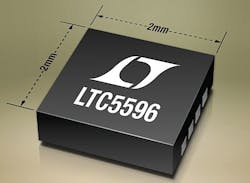RF and microwave power detector for radar, avionics, SATCOM, and testing introduced by Linear
MILPITAS, Calif., 18 Nov. 2016. Linear Technology Corp. in Milpitas, Calif., is introducing the LTC5596 high frequency, wideband and high dynamic range RF and microwave RMS power detector for radar systems, avionics, satellite communications (SATCOM), wireless infrastructure base stations, and test instrumentation.
The LTC5596 measures the power of RF and microwave signals independently of modulation and waveforms. The LTC5596 responds in a log-linear 29 millivolt per decibel scale to signal levels from -37dBm to -2dBm, at accuracy better than ±1dB error over the full operating temperature range and RF frequency range, from 200 MHz to 30 GHz.
The device's response has ±1dB flatness within this frequency range. A wider frequency range can be used, from 100 MHz to 40 GHz, however with slightly reduced accuracy at the frequency extremes. Its RF input is internally 50 Ohm matched from 100 MHz to 40 GHz.
4G and 5G broadband communications systems employ high order, multi-tone OFDM modulation. Traditionally, microwave Schottky diodes are used as the detector element. They face serious shortcomings when rectifying the RF or microwave signals while measuring only the peak of the waveform, which grossly misrepresents the real power of the signal.
In contrast, RMS detectors perform an analog root-mean-square computation of the waveform, then average the result to derive a power representation of the input signal, regardless of its modulation, number of carriers and varying amplitudes.
Related: New Hot Swap controller released by Linear Technology
This capability to measure the power is critical for equipment manufacturers to set the proper transmit power, ensuring the maximum transmission distance and thus improves TX range while remaining compliant with regulatory power limits.
The LTC5596's wide bandwidth enables the detector to work across several frequency bands using a common design with minimum calibration. For example, the LTC5596 works equally well in a sub-10 GHz backhaul microwave link as with a 28 GHz version.
The LTC5596 operates from a 3.3-volt power supply, drawing a nominal supply current of 30 milliamps. The detector has built-in ESD protection, and all pins can withstand as much as a 3,500-volt discharge, human body model.
Two temperature grades are available. An I grade is designed for operation from -40 to 105 degrees Celsius case. For applications subject to extraordinarily high temperature operating environments such as in high power RF power amplifiers, a high temperature H-grade is offered with rated temperature from -40 to 125 C case.
For more information contact Linear Technology online at www.linear.com.
Learn more: search the Aerospace & Defense Buyer's Guide for companies, new products, press releases, and videos
